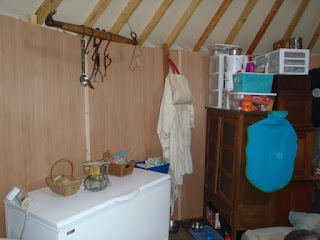We'll be using a composting toilet while waiting on the house. The yurt is awfully small, so we opted for a little dunny (outhouse) to host the composting toilet. We are using the same system that we used for 7 years in Maine, though we had the composting toilet located in the bathroom in the house.
I wanted a lot of light and we also built this on a budget. We used a horse stall mat for the floor and brought it up to the level of the 2 x4's framing the walls/door of the dunny. We built the wall frames at the rental, like we did the solar shed. Then we hauled them up to the property in our truck and put it all together.
 |
| Shows dunny location in relation to yurt. |
 |
| Dunny in progress. |
We used "grooved" paneling, usually used inside. It isn't super smooth, though, so kind of rough and rustic. I will be using boiled linseed oil on the outside to protect the wood. I intend to paint the inside with an exterior paint to make it easier to clean.
 |
| Nearly finished. |
I wanted a lot of light to deter spiders and keep it from seeming the dark, nasty outhouses of old. I am afraid I may have gone over board and we will cook in it in the summer. We'll see. I may need to make some curtains, however, I think we'll enjoy it for sure this winter!
 |
| View from Dunny. |
 |
| View through dunny window. |
When siting the dunny, we considered ease of access from the yurt, a mostly level location to decrease our work and a good view.😊
 |
| Interior. |
We made our dunny 4'x4'. We hemmed and hawed a bit, looked on line for size suggestions. Brent decided that a corner seat was more interesting. He used a piece of the same grooved paneling and cut slices into it where it would need to bend and then steamed it. It turned out great!
In Maine, we used stainless steel 5 g buckets, but they are VERY expensive and multiple friends of ours just use 5 g plastic buckets, so that is the route we went this time. We've got two, but might get another for our rotation.
 |
| Corner seat. |
 |
| Dunny door with window. |
So, the window does look a little funny. The roofing material it is made from only comes in one width. That determined the height of our window. We placed it such that you can see the view from the dunny while seated, as that was the main point of having a window in the door.
So, joining our little dunny is an outdoor shower. We aren't finished with it yet, as we will be building a little surround for it. But here's what we currently have.
We've got a leveled area right next to the dunny for our shower. We took a nice pallet and sanded it, then linseed oiled it. We have an old rubber mat with holes in it for standing on.
We took a 3 gallon garden sprayer, cut off the plastic wand part from the hose it came with. We bought 6ft of clear flexible hose and attached it to the cut off end of the black hose coming out of the garden sprayer. See below.
We found a hose barb that fit into the black hose (also used a clamp on it) and a female end. We were only able to find an elbow with the right sizing on both ends, but it works fine. So that elbow barb screwed into the female end of the hose barb on one end and on the other the barb stuck into the clear hose (clamp again). We attached our low water use shower head using the other elbow. The male end screwed right into the shower head and then the barb end stuck into the clear hose (clamp again). The shower head we used has an on/off lever which is very handy and we recommend it.
We intend to build a surround of opaque corrugated poly roofing. That will help with keeping it warmer if the sun is out as well as provide some privacy.



































